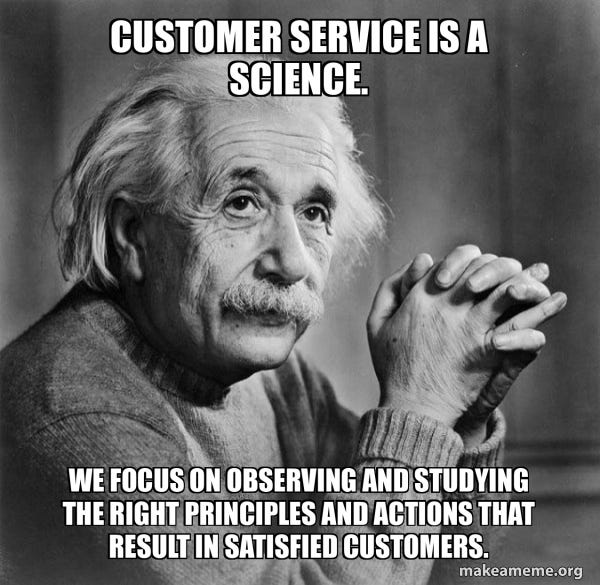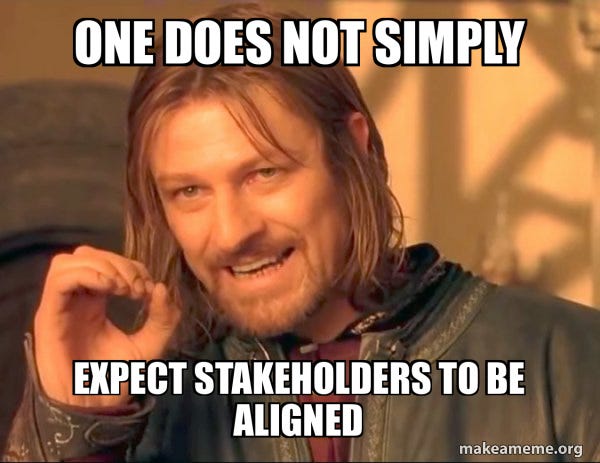Why You Need To Value Your Stakeholders More
Navigating the delicate balance between stakeholder input and product vision can be tricky, but it's a skill that can elevate your product management game.
Have you ever found yourself in a heated debate with a stakeholder, wondering if they are trying to derail your carefully crafted product vision? Well, you're not alone. The relationship between product managers and stakeholders can sometimes feel like a back-and-forth, with each side pulling in opposite directions.
But here's the thing: while it's easy to dismiss stakeholders as outsiders, their input can be invaluable if approached with the right mindset.
Let's explore why taking stakeholders' views into account is not just a political move, but a strategic one that can lead to better products and stronger relationships. 🤝
Addressing the Elephant in the Room
Yes, some stakeholders can be challenging to work with. They might push for features that don't align with your vision, or they might not fully understand the technical constraints you're working under. It's tempting to write them off as power-hungry creatures.
Unfortunately, like it or not, it is true that some stakeholders may even have the power to derail your roadmap causing a domino effect that affects team morale and customer perception.
But if you want to prevent this, here's a perspective shift for you:
What if we viewed stakeholders not as obstacles, but as potential allies in our quest to build amazing products?
As Adam Thomas points out in his thought-provoking post, our strategies often feel right because they align with our own biases and experiences. Yet stakeholders can provide a valuable outside perspective that challenges our assumptions and pushes us to think differently.
It's not just about what you believe to be the best decision; it's about managing relationships and ensuring that all voices are heard. By valuing stakeholder input, you can foster collaboration rather than contention.
Types of Stakeholders and Their Value
Not all stakeholders are created equal. Understanding the different types can help you leverage their unique insights.
The Visionary Executive 👩🏻💼
They may not know the technical details, but they have a bird's-eye view of the market and company strategy.
Characteristics:
Big-picture thinker focused on aligning the product with company strategy.
Often concerned with market positioning, revenue growth, and long-term goals.
May lack technical details but compensates with strategic foresight.
What They Might Say:
“How does this align with our five-year growth plan?”
“We need to be the first to market with this feature—speed is everything.”
“This product should position us as an industry leader.”
How to Work With Them:
Speak their language: focus on ROI, competitive advantage, and strategic impact.
Provide clear roadmaps that show how your work aligns with their vision.
Be prepared to balance their ambitious goals with “realistic” timelines.
The Seasoned Veteran 👨🏼💼
They've been around the block and can help you avoid repeating past mistakes.
Characteristics:
Often someone who has been with the company for years and has seen it all.
Deeply knowledgeable about past successes and failures.
Focused on avoiding mistakes that have been made before.
What They Might Say:
“We tried something similar five years ago, and it didn’t work because…”
“This reminds me of that project back in 2018—here’s what we learned.”
“Are we sure this approach won’t repeat past issues?”
How to Work With Them:
Respect their experience by asking for historical context and lessons learned.
Show how your approach addresses past pitfalls while adapting to current realities.
Use their insights to refine your strategy and avoid reinventing the wheel.
The Customer Advocate 👩⚖️
They're in touch with user needs and can provide valuable feedback on feature ideas.
Characteristics:
Often from sales, customer success, or support teams.
Deeply connected to user pain points and needs.
Passionate about delivering value to customers but may prioritize short-term fixes over long-term strategy.
What They Might Say:
“Our customers keep asking for this feature—why isn’t it on the roadmap yet?”
“We’re losing deals because competitors offer X.”
“If we don’t fix this bug soon, we’re going to lose trust.”
How to Work With Them:
Acknowledge their concerns by gathering data on customer feedback.
Balance their urgency with your product’s broader strategic goals.
Share how customer insights are influencing prioritization decisions.
The Technical Guru 🤓
They understand the system's architecture and can flag potential implementation challenges.
Characteristics:
Often an engineer or technical lead deeply involved in implementation.
Focused on feasibility, scalability, and technical debt.
May challenge ideas that seem impractical or overly ambitious.
What They Might Say:
“This feature will take six months to build—are we sure it’s worth it?”
“Here’s a simpler way we could achieve the same outcome.”
“We need to address technical debt before adding more features.”
How to Work With Them:
Involve them early in discussions about feasibility and trade-offs.
Respect their expertise by being open to alternative solutions.
Collaborate on prioritizing technical improvements alongside new features.
Recognizing these personas in your stakeholders—and tailoring your approach accordingly—you can build trust, foster collaboration, and ultimately create better products.
Now, I’d like to share with you some stories from my experience. 👇
Earning Trust and Valuing Opinions
So, how do you turn potentially adversarial relationships into collaborative ones? Here are some quick and simple strategies I have used:
1. Listen Actively
When stakeholders share their opinions, really listen. Ask probing questions to understand the reasoning behind their suggestions. You might uncover valuable insights you hadn't considered.
💡 Insight
You can find valid concerns doing the right questions. Don’t schedule calls because it is your job, but try to really understand their perspectives and the concerns they bring to the table.
Remember, your goal isn't to blindly implement every stakeholder suggestion. Instead, think of stakeholder input as additional data points to inform your decision-making.
2. Communicate Clearly
Explain your product vision and strategy clearly. When stakeholders understand the bigger picture, they're more likely to provide relevant and valuable input.
💡 Insight
Regardless of the size of your audience, I suggest you go prepared in case you have to talk to them, either by email or chat. The least you want to do is overwhelm them with a lot of necessary details and make them lose interest.
Do not repeat the mistake of “this could be another email.”
3. Show the Impact of Their Input
When you incorporate a stakeholder's suggestion, let them know. This builds trust and encourages future collaboration.
💡 Insight
Naturally, people like to help, but most of the time they don't know how. Let your stakeholders know what’s the impact of their decisions in an email or a call congratulating them. This can create a ripple effect where:
They feel more confident to help you out / support you.
Others can start changing their biases towards you into something more positive (if they are biased against product managers).
4. Be Transparent About Constraints
If you can't implement a stakeholder's idea, explain why. Being open about technical, time, or resource constraints helps stakeholders understand your decision-making process.
💡 Insight
There was a stakeholder who often valued Feature X more highly and compared with my team’s work all the time. In her head, our feature was “just a slightly addition” to the work she did last year. Despite her countless attempts to minimize what we are doing, I scheduled an appointment with other two stakeholders that were more technical and worked in Feature X.
This call went very well, as these tech experts were able to objectively distinguish between the two functionalities. It wasn't about telling her “you're wrong,” but about bringing different perspectives to the table and educating all of us.
Honestly, I was prepared even to hear from technology experts to the contrary, so when I said educate us all, I meant it. Focus should be the product and our users.
5. Involve Them Early
Don't wait until the product is almost finished to seek input. Involving stakeholders early in the process makes them feel valued and gives you more time to incorporate their insights.
💡 Insight
A couple of weeks ago, I consulted two of our stakeholders for an implementation. Both A and B were technically correct and feasible, even from the user's point of view it made no difference which one to implement.
But there was an opportunity to improve the experience for our customers. See, by implementing this feature, we could either
A) Copy the current flow and let the administrators edit this information (development would be easier, as we would almost copy and paste the components) or
B) Go deeper into development and implement a solution where the administrators didn't have to touch anything at all. Not even think about this process and the system would automatically do it for them.
Plan B rings a bell for them as no one consulted them for the process that was already in place. They would have liked the product manager or someone else at the time to have had the courtesy to understand “how does this affect your current workflow?”.
Trust regained! 🖐️
Wrapping Up
Considering stakeholder opinions doesn't mean sacrificing your product vision or autonomy as a product manager. Instead, it's about enriching your decision-making process with diverse perspectives and insights.
As industry leaders, we often pride ourselves on our ability to make tough decisions. But the best decisions often come from considering multiple perspectives.
Stakeholders can provide those diverse viewpoints, challenging our assumptions and pushing us to think more creatively.
So the next time a stakeholder comes to you with an opinion, I suggest to resist the urge to dismiss it outright. 😅 Instead, listen, analyze, and consider how their perspective might enhance your product strategy. You might be surprised at the valuable insights you uncover!
What's your experience with stakeholder input? Have you had any game-changing insights from unexpected sources? Share your thoughts in the comments below!











Useful categories. It’s always a good and proactive approach to look for stakeholders as partners instead of greedy judges.